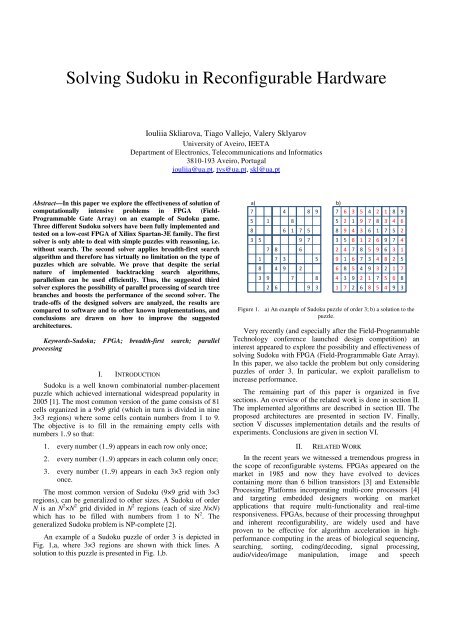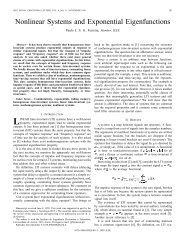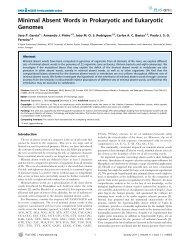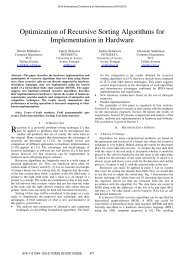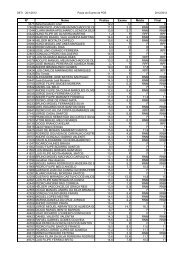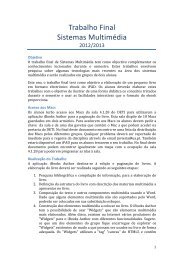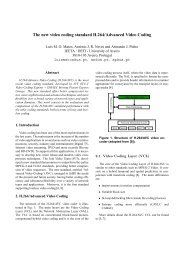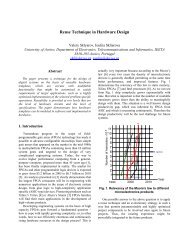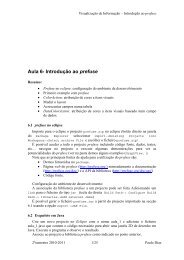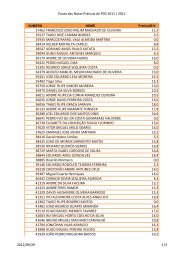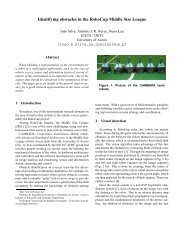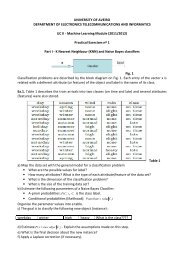Solving Sudoku in Reconfigurable Hardware - Sweet
Solving Sudoku in Reconfigurable Hardware - Sweet
Solving Sudoku in Reconfigurable Hardware - Sweet
You also want an ePaper? Increase the reach of your titles
YUMPU automatically turns print PDFs into web optimized ePapers that Google loves.
<strong>Solv<strong>in</strong>g</strong> <strong>Sudoku</strong> <strong>in</strong> <strong>Reconfigurable</strong> <strong>Hardware</strong><br />
Iouliia Skliarova, Tiago Vallejo, Valery Sklyarov<br />
University of Aveiro, IEETA<br />
Department of Electronics, Telecommunications and Informatics<br />
3810-193 Aveiro, Portugal<br />
iouliia@ua.pt, tvs@ua.pt, skl@ua.pt<br />
Abstract—In this paper we explore the effectiveness of solution of<br />
computationally <strong>in</strong>tensive problems <strong>in</strong> FPGA (Field-<br />
Programmable Gate Array) on an example of <strong>Sudoku</strong> game.<br />
Three different <strong>Sudoku</strong> solvers have been fully implemented and<br />
tested on a low-cost FPGA of Xil<strong>in</strong>x Spartan-3E family. The first<br />
solver is only able to deal with simple puzzles with reason<strong>in</strong>g, i.e.<br />
without search. The second solver applies breadth-first search<br />
algorithm and therefore has virtually no limitation on the type of<br />
puzzles which are solvable. We prove that despite the serial<br />
nature of implemented backtrack<strong>in</strong>g search algorithms,<br />
parallelism can be used efficiently. Thus, the suggested third<br />
solver explores the possibility of parallel process<strong>in</strong>g of search tree<br />
branches and boosts the performance of the second solver. The<br />
trade-offs of the designed solvers are analyzed, the results are<br />
compared to software and to other known implementations, and<br />
conclusions are drawn on how to improve the suggested<br />
architectures.<br />
Keywords-<strong>Sudoku</strong>; FPGA; breadth-first search; parallel<br />
process<strong>in</strong>g<br />
I. INTRODUCTION<br />
<strong>Sudoku</strong> is a well known comb<strong>in</strong>atorial number-placement<br />
puzzle which achieved <strong>in</strong>ternational widespread popularity <strong>in</strong><br />
2005 [1]. The most common version of the game consists of 81<br />
cells organized <strong>in</strong> a 9×9 grid (which <strong>in</strong> turn is divided <strong>in</strong> n<strong>in</strong>e<br />
3×3 regions) where some cells conta<strong>in</strong> numbers from 1 to 9.<br />
The objective is to fill <strong>in</strong> the rema<strong>in</strong><strong>in</strong>g empty cells with<br />
numbers 1..9 so that:<br />
1. every number (1..9) appears <strong>in</strong> each row only once;<br />
2. every number (1..9) appears <strong>in</strong> each column only once;<br />
3. every number (1..9) appears <strong>in</strong> each 3×3 region only<br />
once.<br />
The most common version of <strong>Sudoku</strong> (9×9 grid with 3×3<br />
regions), can be generalized to other sizes. A <strong>Sudoku</strong> of order<br />
N is an N 2 ×N 2 grid divided <strong>in</strong> N 2 regions (each of size N×N)<br />
which has to be filled with numbers from 1 to N 2 . The<br />
generalized <strong>Sudoku</strong> problem is NP-complete [2].<br />
An example of a <strong>Sudoku</strong> puzzle of order 3 is depicted <strong>in</strong><br />
Fig. 1,a, where 3×3 regions are shown with thick l<strong>in</strong>es. A<br />
solution to this puzzle is presented <strong>in</strong> Fig. 1,b.<br />
a) b)<br />
7<br />
5 1<br />
8<br />
3 5<br />
1<br />
8<br />
7<br />
3 9<br />
2<br />
8<br />
4<br />
7 3<br />
4 9<br />
6<br />
8<br />
6 1<br />
7<br />
7 5<br />
9 7<br />
6<br />
2<br />
8 9<br />
5<br />
8<br />
9 3<br />
7 6 3<br />
5 2 1<br />
8 9 4<br />
3 5 8<br />
2 4 7<br />
9 1 6<br />
6 8 5<br />
4 3 9<br />
1 7 2<br />
5 4 2<br />
9 7 8<br />
3 6 1<br />
1 2 6<br />
8 5 9<br />
7 3 4<br />
4 9 3<br />
2 1 7<br />
6 8 5<br />
1 8 9<br />
3 4 6<br />
7 5 2<br />
9 7 4<br />
6 3 1<br />
8 2 5<br />
2 1 7<br />
5 6 8<br />
4 9 3<br />
Figure 1. a) An example of <strong>Sudoku</strong> puzzle of order 3; b) a solution to the<br />
puzzle.<br />
Very recently (and especially after the Field-Programmable<br />
Technology conference launched design competition) an<br />
<strong>in</strong>terest appeared to explore the possibility and effectiveness of<br />
solv<strong>in</strong>g <strong>Sudoku</strong> with FPGA (Field-Programmable Gate Array).<br />
In this paper, we also tackle the problem but only consider<strong>in</strong>g<br />
puzzles of order 3. In particular, we exploit parallelism to<br />
<strong>in</strong>crease performance.<br />
The rema<strong>in</strong><strong>in</strong>g part of this paper is organized <strong>in</strong> five<br />
sections. An overview of the related work is done <strong>in</strong> section II.<br />
The implemented algorithms are described <strong>in</strong> section III. The<br />
proposed architectures are presented <strong>in</strong> section IV. F<strong>in</strong>ally,<br />
section V discusses implementation details and the results of<br />
experiments. Conclusions are given <strong>in</strong> section VI.<br />
II.<br />
RELATED WORK<br />
In the recent years we witnessed a tremendous progress <strong>in</strong><br />
the scope of reconfigurable systems. FPGAs appeared on the<br />
market <strong>in</strong> 1985 and now they have evolved to devices<br />
conta<strong>in</strong><strong>in</strong>g more than 6 billion transistors [3] and Extensible<br />
Process<strong>in</strong>g Platforms <strong>in</strong>corporat<strong>in</strong>g multi-core processors [4]<br />
and target<strong>in</strong>g embedded designers work<strong>in</strong>g on market<br />
applications that require multi-functionality and real-time<br />
responsiveness. FPGAs, because of their process<strong>in</strong>g throughput<br />
and <strong>in</strong>herent reconfigurability, are widely used and have<br />
proven to be effective for algorithm acceleration <strong>in</strong> highperformance<br />
comput<strong>in</strong>g <strong>in</strong> the areas of biological sequenc<strong>in</strong>g,<br />
search<strong>in</strong>g, sort<strong>in</strong>g, cod<strong>in</strong>g/decod<strong>in</strong>g, signal process<strong>in</strong>g,<br />
audio/video/image manipulation, image and speech
ecognition, encryption, and many others where significant<br />
speed and power sav<strong>in</strong>gs over traditional microprocessors,<br />
graphics process<strong>in</strong>g units, and digital signal processors were<br />
achieved [5-7].<br />
A number of research works explore the FPGA-based<br />
implementation of computationally <strong>in</strong>tensive problems such as<br />
the Eigenvalues calculation [8], fast Fourier transform [9], data<br />
sort [10], Boolean Satisfiability problem (SAT) [11], Eternity II<br />
[12], and <strong>Sudoku</strong> [13-16].<br />
In [13] a probabilistic <strong>Sudoku</strong> solver is presented based on<br />
simulated anneal<strong>in</strong>g methods. The solver was implemented on<br />
a Xil<strong>in</strong>x Virtex-II FPGA, ran at 53 MHz and is capable of<br />
handl<strong>in</strong>g puzzles up to 12 th order. The obta<strong>in</strong>ed results were<br />
compared to the implementation of exactly the same algorithm<br />
<strong>in</strong> software and the authors reports that both systems behaved<br />
similarly <strong>in</strong> terms of performance (FPGA was faster for lower<br />
order puzzles, software performed better for higher order<br />
puzzles). The suggested technique is not applicable to hard<br />
<strong>in</strong>stances (none of the tested “hard” puzzles was solved <strong>in</strong><br />
[13]).<br />
<strong>Hardware</strong> implementation of an exhaustive search<br />
algorithm for <strong>Sudoku</strong> (which does not use any search space<br />
prun<strong>in</strong>g) is presented <strong>in</strong> [14]. The solver was implemented <strong>in</strong> a<br />
Xil<strong>in</strong>x Virtex-II FPGA, supported 50 MHz clock frequency and<br />
was able to tackle problems up to order 8. Once aga<strong>in</strong> the<br />
technique is not applicable to hard <strong>in</strong>stances because the search<br />
is not directed.<br />
Another FPGA-based <strong>Sudoku</strong> solver is proposed <strong>in</strong> [15]. In<br />
this case, the backtrack<strong>in</strong>g search algorithm is augmented with<br />
several heuristics that lead to search space reduction. The<br />
solver can process puzzles up to order 11.<br />
In [16] depth-first search algorithm is implemented and a<br />
new memory scheme is proposed which allowed to reduce<br />
memory requirements of [13-15] and to solve puzzles up to<br />
order 14 <strong>in</strong> a Spartan-3E FPGA. Parallelization was <strong>in</strong>troduced<br />
as well. The results were compared to a state-of-the-art SAT<br />
solver (by model<strong>in</strong>g <strong>Sudoku</strong> as the SAT problem as <strong>in</strong> [17])<br />
and the authors found that their FPGA-based implementation<br />
can only speed up easy puzzles while the hard ones are<br />
processed slower than <strong>in</strong> software.<br />
In this work we further explore the problem with particular<br />
emphasis on implement<strong>in</strong>g: a) a backtrack<strong>in</strong>g search algorithm<br />
with search space prun<strong>in</strong>g; b) a number of parallel <strong>Sudoku</strong><br />
solvers (all the overviewed research works po<strong>in</strong>ted that stateof-the-art<br />
software solv<strong>in</strong>g methods are more competitive and<br />
therefore parallelism must be the ma<strong>in</strong> target of hardware<br />
implementations).<br />
III.<br />
IMPLEMENTED ALGORITHMS<br />
For every empty cell <strong>in</strong> a puzzle a list of possibilities must<br />
be generated. This list <strong>in</strong>cludes all the numbers that<br />
theoretically could be placed <strong>in</strong> each cell (tak<strong>in</strong>g <strong>in</strong>to account<br />
the current puzzle constra<strong>in</strong>ts).<br />
The follow<strong>in</strong>g search space prun<strong>in</strong>g techniques have been<br />
implemented:<br />
• S<strong>in</strong>gles: when a cell has only one candidate number to<br />
be used, this number is assigned to that cell and<br />
removed from the lists of candidates <strong>in</strong> all other cells <strong>in</strong><br />
the same row, column, and region;<br />
• Hidden S<strong>in</strong>gles: if a candidate number appears only<br />
once <strong>in</strong> a given row, column or region, it is assigned to<br />
the respective cell.<br />
When further prun<strong>in</strong>g is not possible, we recur to a<br />
backtrack<strong>in</strong>g algorithm which:<br />
1. F<strong>in</strong>ds a cell with the smallest number of candidates;<br />
2. Tries those candidates one by one (perform<strong>in</strong>g problem<br />
simplification as described above);<br />
3. If a cell without candidates appears it means that this<br />
trial was wrong and the algorithm backtracks to<br />
explore the rema<strong>in</strong><strong>in</strong>g possibilities; otherwise go to<br />
po<strong>in</strong>t 1 above;<br />
4. The algorithm stops when all the cells become filled<br />
with a valid number.<br />
Basically, we implemented two algorithms: A simple , which<br />
just performs prun<strong>in</strong>g of the search space and therefore can<br />
only solve very simple puzzles and A search , which applies<br />
breadth-first search strategy and thus has virtually no limitation<br />
on the type of puzzles which are solvable. The flowcharts of<br />
both algorithms are presented <strong>in</strong> Fig. 2.<br />
IV.<br />
PROPOSED ARCHITECTURES<br />
Three different <strong>Sudoku</strong> solver architectures have been<br />
implemented. The first solver S simple implements the algorithm<br />
A simple and is therefore only able to solve simple puzzles with<br />
reason<strong>in</strong>g, i.e. without search. The second solver S search applies<br />
breadth-first search algorithm A search and can process any<br />
puzzle (provided memory is available). And, f<strong>in</strong>ally, the third<br />
solver S parallel implements the algorithm A search and explores the<br />
possibility of parallel process<strong>in</strong>g of nodes <strong>in</strong> the search tree. In<br />
particular, all the sub-puzzles which are <strong>in</strong>stantiated at the same<br />
level <strong>in</strong> the search tree are solved <strong>in</strong> parallel. Moreover, if<br />
further branch<strong>in</strong>g occurs, the new lower level sub-puzzles are<br />
also executed <strong>in</strong> parallel with those already runn<strong>in</strong>g.<br />
A. Organization of Data <strong>in</strong> Memory<br />
Table I gives <strong>in</strong>formation about data stored <strong>in</strong> memory <strong>in</strong><br />
our approach.<br />
Name<br />
puzzle<br />
auxiliary puzzle(s)<br />
candidates<br />
map of columns<br />
map of regions<br />
map of m<strong>in</strong>imals<br />
map of <strong>in</strong>dices<br />
TABLE I.<br />
MEMORY REQUIREMENTS<br />
Description<br />
puzzle itself<br />
copies of the puzzle which are required by the<br />
solvers S search and S parallel<br />
lists of candidates for every cell<br />
column <strong>in</strong>dex for every cell<br />
region <strong>in</strong>dex for every cell<br />
ordered (by the number of candidates) list of<br />
cells<br />
<strong>in</strong>dicates which memories are free (to be used by<br />
the solvers S search and S parallel)
a) b)<br />
Figure 2. a) Flowchart of the algorithm A simple which is only able to solve simple puzzles by prun<strong>in</strong>g the search space; b) Flowchart of the algorithm A search which<br />
applies breadth-first search strategy.<br />
The orig<strong>in</strong>al puzzle as well as auxiliary puzzles are stored<br />
<strong>in</strong> memory as 81 (9×9) 4-bit words (see Fig. 3,a), where every<br />
cell value is represented by the respective b<strong>in</strong>ary code (code<br />
“0000” is reserved for empty cells).<br />
Each cell might have up to 9 candidate numbers (<strong>in</strong> the<br />
worst case). Therefore we store the list of candidates as 81<br />
36(9×4)-bit words, where every word is organized as illustrated<br />
<strong>in</strong> Fig. 4. For example, the cell A1 from Fig. 3 already has a<br />
value. Therefore this cell does not have any candidate and all<br />
36 bits are assigned to zero. The cell A2 has two possible<br />
candidate numbers: 2 and 6. So, these numbers are coded <strong>in</strong><br />
b<strong>in</strong>ary and occupy 4 bits each as illustrated <strong>in</strong> Fig. 4; the<br />
rema<strong>in</strong><strong>in</strong>g bits are assigned to zero. The cell A4 has three<br />
possible candidate numbers: 2, 3, and 5, which are coded <strong>in</strong><br />
b<strong>in</strong>ary with 4 bits each as shown <strong>in</strong> Fig. 4.<br />
The maps of columns and regions are used to f<strong>in</strong>d easily<br />
which column or region does a particular cell belong to. These<br />
memories are organized as 81 (9×9) 4-bit words (see Fig.<br />
3,b,c). The maps of columns and regions are implemented as<br />
ROMs whose contents is def<strong>in</strong>ed statically and does not change<br />
dur<strong>in</strong>g the solution of a problem (as well as when we switch<br />
between different problem <strong>in</strong>stances). These maps are not<br />
required <strong>in</strong> software but we found that they facilitate memory<br />
address<strong>in</strong>g <strong>in</strong> hardware.<br />
The map of m<strong>in</strong>imals keeps ordered (by the number of<br />
candidates) addresses of cells and is used <strong>in</strong> branch<strong>in</strong>g (<strong>in</strong> order<br />
to split the search on the cell that has the smallest number of<br />
candidates). This memory is organized as 81 7-bit words.<br />
A<br />
B<br />
C<br />
D<br />
E<br />
F<br />
G<br />
H<br />
I<br />
A<br />
B<br />
C<br />
D<br />
E<br />
F<br />
G<br />
H<br />
I<br />
b)<br />
1 2 3 4 5 6 7 8 9<br />
1 2 3 4 5 6 7 8 9<br />
1 2 3 4 5 6 7 8 9<br />
1 2 3 4 5 6 7 8 9<br />
1 2 3 4 5 6 7 8 9<br />
1 2 3 4 5 6 7 8 9<br />
1 2 3 4 5 6 7 8 9<br />
1 2 3 4 5 6 7 8 9<br />
1 2 3 4 5 6 7 8 9<br />
1 2 3 4 5 6 7 8 9<br />
c)<br />
1 2 3 4 5 6 7 8 9<br />
1 1 1 2 2 2 3 3 3<br />
1 1 1 2 2 2 3 3 3<br />
1 1 1 2 2 2 3 3 3<br />
4 4 4 5 5 5 6 6 6<br />
4 4 4 5 5 5 6 6 6<br />
4 4 4 5 5 5 6 6 6<br />
7 7 7 8 8 8 9 9 9<br />
7 7 7 8 8 8 9 9 9<br />
7 7 7 8 8 8 9 9 9<br />
A<br />
B<br />
C<br />
D<br />
E<br />
F<br />
G<br />
H<br />
I<br />
1 2 3 4 5 6 7 8 9<br />
a)<br />
7<br />
5 1<br />
8<br />
3 5<br />
1<br />
8<br />
7 8<br />
3 9<br />
4<br />
8<br />
8 9<br />
6 1 7 5<br />
7 3<br />
4 9<br />
2 6<br />
7<br />
9 7<br />
6<br />
2<br />
5<br />
8<br />
9 3<br />
a) b) c)<br />
0 0001 0 0001<br />
1 0010 1 0001<br />
2 0011 2 0001<br />
3 0100 3 0010<br />
4<br />
5<br />
0101<br />
4<br />
5 0010<br />
6 0110 6 0010<br />
7 0111 7 0011<br />
8 1000 8 0011<br />
9 1001 9 0011<br />
10 0001 10 0001<br />
11 0010 11 0001<br />
12 0011 12 0001<br />
13 0100 13 0010<br />
14 0101 14 0010<br />
15<br />
16<br />
0110<br />
15<br />
16<br />
0010<br />
17 0111 17 0011<br />
18 1000 18 0011<br />
19 1001 19 0011<br />
0111<br />
0000<br />
0000<br />
0000<br />
0100<br />
0000<br />
0000<br />
1000<br />
1001<br />
0101<br />
0000<br />
0001<br />
0000<br />
0000<br />
1000<br />
0000<br />
0000<br />
0000<br />
0000<br />
0000<br />
0010<br />
0110<br />
0000<br />
0000<br />
0000<br />
1001<br />
0011<br />
71<br />
72<br />
73<br />
74<br />
75<br />
76<br />
77<br />
78<br />
79<br />
80<br />
0001<br />
0010<br />
0011<br />
0100<br />
0101<br />
0110<br />
0111<br />
1000<br />
1001<br />
71<br />
72<br />
73<br />
74<br />
75<br />
76<br />
77<br />
78<br />
79<br />
80<br />
0111<br />
0111<br />
0111<br />
1000<br />
1000<br />
1000<br />
1001<br />
1001<br />
1001<br />
Figure 3. Representation of data <strong>in</strong> memory: a) stor<strong>in</strong>g the orig<strong>in</strong>al and<br />
auxiliary puzzles; b) map of columns; c) map of regions.<br />
0<br />
1<br />
2<br />
3<br />
4<br />
5<br />
6<br />
7<br />
8<br />
9<br />
10<br />
11<br />
12<br />
13<br />
14<br />
15<br />
16<br />
17<br />
18<br />
19<br />
71<br />
72<br />
73<br />
74<br />
75<br />
76<br />
77<br />
78<br />
79<br />
80
A1 0000 0000 0000 0000 0000 0000 0000 0000 0000 0<br />
A2 0010 0110 0000 0000 0000 0000 0000 0000 0000 1<br />
A3 0011 0110 0000 0000 0000 0000 0000 0000 0000 2<br />
A4 0010 0011 0101 0000 0000 0000 0000 0000 0000 3<br />
…<br />
I9 0000 0000 0000 0000 0000 0000 0000 0000 0000 80<br />
Figure 4. Representation of the lists of candidates <strong>in</strong> memory.<br />
F<strong>in</strong>ally, the map of <strong>in</strong>dices po<strong>in</strong>ts out which memories are<br />
free and can therefore be used for stor<strong>in</strong>g auxiliary puzzles <strong>in</strong><br />
the solvers S search and S parallel . This memory is composed of 32<br />
1-bit flags and can be used for manag<strong>in</strong>g at most 32 auxiliary<br />
puzzles (but is easily scalable to deal with more puzzles). At<br />
the beg<strong>in</strong>n<strong>in</strong>g of execution, the map is filled <strong>in</strong> with zeros.<br />
B. Solvers Architectures<br />
The block diagrams of the solvers S simple and S search are<br />
illustrated <strong>in</strong> Fig. 5 and Fig. 6. The first solver S simple (see Fig.<br />
5) is able to process very simple puzzles that can be solved<br />
without branch<strong>in</strong>g by apply<strong>in</strong>g two reduction techniques:<br />
S<strong>in</strong>gles and Hidden S<strong>in</strong>gles. The Control Unit manages access<br />
to memory blocks (which hold the orig<strong>in</strong>al puzzle, the list of<br />
candidate numbers, the map of columns, and the map of<br />
regions) with the aid of a priority encoder and multiplexers for<br />
addresses, data and write enable signals. The access is<br />
arbitrated between external <strong>in</strong>terface (for example, USB<br />
<strong>in</strong>terface to a host computer) and three VHDL processes, which<br />
are responsible for application of the two reduction techniques<br />
(s<strong>in</strong>gles and hidden s<strong>in</strong>gles processes) and updat<strong>in</strong>g the list of<br />
candidate numbers (list of candidates process) accord<strong>in</strong>g to the<br />
algorithm A simple (see Fig. 2,a). The processes are implemented<br />
as communicat<strong>in</strong>g f<strong>in</strong>ite state mach<strong>in</strong>es [18].<br />
The second solver S search (see Fig. 6) applies breadth-first<br />
search algorithm as soon as it concludes that further reduction<br />
is not possible. The process f<strong>in</strong>d m<strong>in</strong>imal is responsible for<br />
f<strong>in</strong>d<strong>in</strong>g an empty cell C which has the smallest number of<br />
candidates n. Then n copies of the puzzle are done and each of<br />
these has the cell C filled with one of the candidates. After that<br />
the copied auxiliary puzzles are processed by the solver one by<br />
one sequentially accord<strong>in</strong>g to the algorithm A search (see Fig.<br />
2,b) eventually creat<strong>in</strong>g more copies of the sub-puzzles which<br />
are added to the end of the queue and processed <strong>in</strong> the order of<br />
their <strong>in</strong>stantiation. The process check solution is responsible for<br />
verify<strong>in</strong>g if the current puzzle is completely filled <strong>in</strong> and a<br />
solution was found, a case <strong>in</strong> which the Control Unit has to<br />
stop runn<strong>in</strong>g the rema<strong>in</strong><strong>in</strong>g puzzles.<br />
With this architecture any <strong>Sudoku</strong> puzzle can be solved<br />
provided there is memory available for keep<strong>in</strong>g auxiliary<br />
copies as described above. Access to memories (which store<br />
the list of the candidates and different maps) is arbitrated by the<br />
Control Unit <strong>in</strong> a way similar to the solver S simple . Access to K<br />
puzzles is controlled with the aid of a demultiplexer (not shown<br />
<strong>in</strong> Fig. 6 for the sake of simplicity) activated by <strong>in</strong>dex supplied<br />
by the Control Unit. As soon as a solution is found, data from<br />
the respective puzzle are sent to the external <strong>in</strong>terface via a<br />
multiplexer (also not shown <strong>in</strong> Fig. 6) controlled by <strong>in</strong>dex from<br />
the Control Unit.<br />
puzzle<br />
candidates<br />
map of<br />
columns<br />
map of<br />
regions<br />
memories<br />
data<br />
addr<br />
d<strong>in</strong><br />
we<br />
data<br />
priority<br />
encoder<br />
Control unit<br />
external<br />
<strong>in</strong>terface<br />
s<strong>in</strong>gles<br />
hidden<br />
s<strong>in</strong>gles<br />
list of<br />
candidates<br />
processes<br />
Figure 5. Block diagrams of the solver S simple.<br />
puzzle 1<br />
puzzle 2<br />
puzzle K<br />
memories<br />
<strong>in</strong>dex<br />
candidates<br />
map of<br />
columns<br />
map of<br />
regions<br />
map of<br />
m<strong>in</strong>imals<br />
map of<br />
<strong>in</strong>dices<br />
data<br />
addr<br />
d<strong>in</strong><br />
we<br />
data<br />
priority<br />
encoder<br />
Control Unit<br />
external<br />
<strong>in</strong>terface<br />
s<strong>in</strong>gles<br />
hidden<br />
s<strong>in</strong>gles<br />
list of<br />
candidates<br />
check<br />
solution<br />
f<strong>in</strong>d<br />
m<strong>in</strong>imal<br />
processes<br />
Figure 6. Block diagrams of the solver S search.<br />
F<strong>in</strong>ally, the block diagram of the third solver S parallel is<br />
illustrated <strong>in</strong> Fig. 7 and Fig. 8. The solver is started by<br />
activat<strong>in</strong>g the first eng<strong>in</strong>e Solver 1. Each solv<strong>in</strong>g eng<strong>in</strong>e (see<br />
Fig. 7) is only responsible for apply<strong>in</strong>g S<strong>in</strong>gles and Hidden<br />
S<strong>in</strong>gles reduction techniques and for f<strong>in</strong>d<strong>in</strong>g a cell C with the<br />
m<strong>in</strong>imum number of candidate numbers n. Information about<br />
the cell C is then sent to the Parallel Control Unit (see Fig. 8)<br />
which makes n copies of the puzzle and activates n next<br />
available solv<strong>in</strong>g eng<strong>in</strong>es which all execute <strong>in</strong> parallel. As soon<br />
as one of these eng<strong>in</strong>es needs to branch the search space the<br />
process repeats by activat<strong>in</strong>g n new more solv<strong>in</strong>g eng<strong>in</strong>es. As<br />
soon as one of them reports that a solution is found the Parallel
Control Unit aborts all the rema<strong>in</strong><strong>in</strong>g solv<strong>in</strong>g eng<strong>in</strong>es and<br />
notifies the respective external entity and data from the relevant<br />
solv<strong>in</strong>g eng<strong>in</strong>e are sent to external <strong>in</strong>terface via a multiplexer.<br />
As <strong>in</strong> the previous case, with this architecture any <strong>Sudoku</strong><br />
puzzle can be solved provided resources are available for<br />
implement<strong>in</strong>g the required number of solv<strong>in</strong>g eng<strong>in</strong>es. Access<br />
to different solv<strong>in</strong>g eng<strong>in</strong>es is controlled with the aid of<br />
demultiplexers activated by the respective <strong>in</strong>dex supplied by<br />
the Parallel Control Unit.<br />
puzzle<br />
candidates<br />
map of<br />
columns<br />
map of<br />
regions<br />
map of<br />
m<strong>in</strong>imals<br />
memories<br />
data<br />
enable<br />
addr<br />
d<strong>in</strong><br />
we<br />
data<br />
priority<br />
encoder<br />
Control Unit<br />
m<strong>in</strong>imal cell solved<br />
candidates<br />
external<br />
<strong>in</strong>terface<br />
s<strong>in</strong>gles<br />
hidden<br />
s<strong>in</strong>gles<br />
list of<br />
candidates<br />
check<br />
solution<br />
f<strong>in</strong>d<br />
m<strong>in</strong>imal<br />
processes<br />
done<br />
Figure 7. Block diagrams of the solver S parallel: structure of the <strong>in</strong>dividual<br />
solv<strong>in</strong>g eng<strong>in</strong>e which does not perform branch<strong>in</strong>g.<br />
Solver<br />
1<br />
Solver<br />
2<br />
Solver<br />
K<br />
V. THE RESULTS OF EXPERIMENTS<br />
All three proposed architectures were described <strong>in</strong> VHDL,<br />
synthesized with Xil<strong>in</strong>x ISE 12.1, and tested on a Nexys-2<br />
prototyp<strong>in</strong>g board conta<strong>in</strong><strong>in</strong>g XC3S1200E FPGA. The FPGA<br />
has 28 18-Kbit embedded memory blocks (BlockRAMs). We<br />
configured each BlockRAM as a s<strong>in</strong>gle-port memory and made<br />
so that every entity described <strong>in</strong> Section IV.A occupies one<br />
BlockRAM. This configuration permitted to implement easily<br />
the solver S simple , to keep up to 21 auxiliary puzzles <strong>in</strong> the<br />
solver S search , and to <strong>in</strong>stantiate at most 5 parallel solv<strong>in</strong>g units<br />
<strong>in</strong> the solver S parallel .<br />
The occupied FPGA resources are summarized <strong>in</strong> Table II.<br />
Please note that although it is possible to keep up to 21<br />
auxiliary puzzles <strong>in</strong> the solver S search , only 12 were <strong>in</strong>stantiated<br />
because these were sufficient for the experiments. That is why<br />
the this solver needs just 19 BlockRAMs.<br />
Experiments were done with benchmarks available at [19-<br />
21]. The results are summarized <strong>in</strong> Tables III-IV. We have<br />
designed a software program (<strong>in</strong> C) which implements the<br />
algorithms A simple and A search . The respective software execution<br />
times t sw (measured on a HP EliteBook 2730p with Inter Core<br />
Duo CPU 1.87 GHz) are presented <strong>in</strong> the rightmost columns of<br />
Tables III-IV. The column “# copied puzzles” gives<br />
<strong>in</strong>formation on how many search tree branches it was necessary<br />
to explore (and, as a consequence, how many puzzle copies<br />
were executed, or how many solv<strong>in</strong>g eng<strong>in</strong>es were activated –<br />
<strong>in</strong> case of the solver S parallel ). The solver S parallel supports at most<br />
5 parallel solv<strong>in</strong>g units and therefore is not able to process the<br />
last 3 <strong>in</strong>stances from the Table IV.<br />
From the Tables you can see that the solvers S simple and<br />
S search are less efficient than the respective software<br />
implementations for all the selected benchmarks. This is an<br />
expected result because these two solvers implement very<br />
control-oriented algorithms and only explore low-level<br />
parallelism (at the level of operations). On the other hand, the<br />
solver S parallel , which explores parallel traversal of the search<br />
tree branches, leads to execution times more closely related to<br />
software solution. The solver S parallel is on average 2.4 times<br />
faster than the solver S search .<br />
TABLE II. FPGA RESOURCES OCCUPIED BY THE IMPLEMENTED SUDOKU<br />
SOLVERS AND THE MAXIMUM ACHIEVABLE CLOCK FREQUENCY<br />
multiplexer<br />
external<br />
<strong>in</strong>terface<br />
demultiplexers<br />
multiplexers<br />
S simple S search S parallel<br />
slices 529 (6%) 961 (11%) 4297 (49%)<br />
BlockRAMs 4 (14%) 19 (67%)* 27 (96%)<br />
freq (MHz) 55.6 43.4 51.7<br />
map of<br />
<strong>in</strong>dices<br />
memory<br />
data<br />
addr<br />
d<strong>in</strong><br />
we<br />
Parallel<br />
Control Unit<br />
Figure 8. Block diagrams of the solver S parallel: K solvers controlled by a<br />
s<strong>in</strong>gle parallel control unit.<br />
data<br />
control<br />
TABLE III.<br />
THE RESULTS OF EXPERIMENTS WITH THE SOLVER SSIMPLE<br />
puzzle S simple (ms) t sw (ms)<br />
Easy Puzzle 1 1.43 0.93<br />
Easy Puzzle 2 0.79 0.59<br />
Easy Puzzle 3 1.20 0.77<br />
Easy Puzzle 4 1.68 0.98<br />
Medium Puzzle 1 3.92 2.04<br />
Medium Puzzle 2 1.57 3.76<br />
Medium Puzzle 3 2.03 1.73<br />
Medium Puzzle 4 3.36 2.87
TABLE IV.<br />
THE RESULTS OF EXPERIMENTS WITH THE SOLVERS SSEARCH<br />
AND SPARALLEL<br />
puzzle S search (ms) S parallel (ms) # copied t sw (ms)<br />
puzzles<br />
Hard Puzzle 5 14.19 5.65 4 5.63<br />
Hard Puzzle 9 20.64 5.43 4 6.94<br />
Hard Puzzle 12 8.16 4.91 2 4.34<br />
Expert Puzzle 1 6.69 4.15 3 3.99<br />
Expert Puzzle 2 22.09 4.98 2 4.78<br />
Extreme Puzzle 5 11.03 5.15 1 3.39<br />
Evil Puzzle 1 22.18 9.57 1 5.53<br />
Evil Puzzle 2 10.56 7.22 3 5.39<br />
Extra Chall 13 18.89 7.26 1 4.92<br />
Evil Puzzle 17 6.22 5.22 1 4.15<br />
Evil Puzzle 5 9.26 5.64 2 5.22<br />
Hard Puzzle 10 7.36 5.09 3 3.36<br />
Expert Puzzle 10 15.24 3.97 1 2.75<br />
Hard Puzzle 10a 11.04 na 8 4.86<br />
Evil Puzzle 5a 24.62 na 7 11.52<br />
Evil Puzzle 17a 18.19 na 7 10.33<br />
We would like to underl<strong>in</strong>e that the experiments were done<br />
on a low-cost FPGA which supports very limited clock<br />
frequency (about 37 times slower that the PC used). If we<br />
migrate the same designs to a more advanced FPGA chip,<br />
obviously better results will be received. Besides, we used a<br />
number of auxiliary test circuits that check the validity of<br />
puzzles frequently. These circuits slow down the solvers and<br />
will be removed <strong>in</strong> future implementations.<br />
We have also compared our results with those of [13-16]<br />
us<strong>in</strong>g a benchmark 3a from the Field-Programmable<br />
Technology conference [22]. The solver S simple was 5 times<br />
faster than [14], 2 times faster than [15] but slower than [16]<br />
(simulated anneal<strong>in</strong>g–based solver [13] was not able to process<br />
3a <strong>in</strong>stance).<br />
VI.<br />
CONCLUSIONS<br />
In this paper three different architectures were presented<br />
that allow a <strong>Sudoku</strong> puzzle to be solved on an FPGA. We<br />
proved that despite the serial nature of the implemented<br />
algorithms, parallelism can be applied efficiently allow<strong>in</strong>g<br />
performance to be <strong>in</strong>creased <strong>in</strong> 2.4 times. Nevertheless, even<br />
the parallel FPGA-based solver is slower than software<br />
solution. This leads to the conclusion that parallelism should be<br />
explored more aggressively. There is room for such exploration<br />
even with the used low-cost FPGA through more efficient data<br />
structures and BlockRAM management.<br />
ACKNOWLEDGMENT<br />
This research was supported by HP grant “Use of HP<br />
Mobile Technology to Enhance Teach<strong>in</strong>g <strong>Reconfigurable</strong><br />
Systems”, FEDER through the Operational Program<br />
Competitiveness Factors - COMPETE and by National Funds<br />
through FCT - Foundation for Science and Technology <strong>in</strong> the<br />
context of project FCOMP-01-0124-FEDER-022682 (FCT<br />
reference PEst-C/EEI/UI0127/2011).<br />
REFERENCES<br />
[1] J.P. Delahaye, “The Science beh<strong>in</strong>d <strong>Sudoku</strong>”, Scientific American<br />
Magaz<strong>in</strong>e, pp. 80-87, June 2006.<br />
[2] T. Yato, T. Seta, “Complexity and Completeness of F<strong>in</strong>d<strong>in</strong>g Another<br />
Solution and its Application to Puzzles”, IEICE Trans. on Fundamentals<br />
of Electronics, Communications and Computer Sciences, vol. E86-A,<br />
no. 5, pp. 1052-1060, 2003.<br />
[3] Xil<strong>in</strong>x products, World’s Highest Capacity FPGA - Now Shipp<strong>in</strong>g (25<br />
October, 2011), available at: http://www.xil<strong>in</strong>x.com/products/silicondevices/fpga/virtex-7/.<br />
[4] M. Santar<strong>in</strong>i, “Zynq-7000 EPP Sets Stage for New Era of Innovations”,<br />
Xcell journal, issue 75, second quarter, available at:<br />
http://www.eetimes.com/design/programmable-logic/4217069/Zynq-<br />
7000-EPP-sets-stage-for-new-era-of-<strong>in</strong>novations, 2011.<br />
[5] B. Cope, P.Y.K. Cheung, W. Luk, L. Howes, “Performance Comparison<br />
of Graphics Processors to <strong>Reconfigurable</strong> Logic: A Case Study”, IEEE<br />
Transactions on computers, vol. 59, no. 4, pp. 433-448, 2010.<br />
[6] S. Chey, J. Liz, J.W. Sheaffery, K. Skadrony, J. Lach, “ Accelerat<strong>in</strong>g<br />
Compute-Intensive Applications with GPUs and FPGAs”, Symposium<br />
on Application Specific Processors, pp. 101-107, Anaheim, California,<br />
USA, June 2008.<br />
[7] M. Lakka, G. Chrysos, I. Papaefstathiou, A. Dollas, “Architecture,<br />
Design, and Experimental Evaluation of a Lightfield Descriptor Depth<br />
Buffer Algorithm on <strong>Reconfigurable</strong> Logic and on a GPU”, IEEE<br />
International Symposium on Field-Programmable Custom Comput<strong>in</strong>g<br />
Mach<strong>in</strong>es, pp. 57-64, Salt Lake City, Utah, USA, May 2011.<br />
[8] I.A. Sajid, M.M. Ahmed, M. Sagheer, ”FPGA-Based Householder<br />
Implementation for Efficient Eigenvalues Calculation”, International<br />
Journal of Innovative Comput<strong>in</strong>g, Information and Control, vol. 7, no.<br />
10, pp. 5939-5946, 2011.<br />
[9] S.T. Pan, C.C. Lai, B.Y. Tsai, “The Implementation of Speech<br />
Recognition Systems on FPGA-Based Embedded Systems with SOC<br />
Architecture”, International Journal of Innovative Comput<strong>in</strong>g,<br />
Information and Control, vol. 7, no. 11, pp. 6161-6175, 2011.<br />
[10] V. Sklyarov, I. Skliarova, D. Mihhailov, and A. Sudnitson,<br />
"Implementation <strong>in</strong> FPGA of Address-based Data Sort<strong>in</strong>g", Proc. 21 st<br />
Int. Conf. on Field Programmable Logic and Applications, pp. 405-410,<br />
Crete, Greece, 2011.<br />
[11] I. Skliarova and A.B. Ferrari, "A SAT Solver Us<strong>in</strong>g Software and<br />
<strong>Reconfigurable</strong> <strong>Hardware</strong>", Proc. Design, Automation and Test <strong>in</strong><br />
Europe Conference, p. 1094, Paris, France, 2002.<br />
[12] P. Malakonakis, A. Dollas, “Exploitation of Parallel Search Space<br />
Evaluation with FPGAs <strong>in</strong> Comb<strong>in</strong>atorial Problems: The Eternity II<br />
Case”, Proc. 21 st Int. Conf. on Field Programmable Logic and<br />
Applications, pp. 264-268, Crete, Greece, September 2011.<br />
[13] P. Malakonakis, M. Smerdis, E. Sotiriades, A. Dollas, “An FPGA-Based<br />
<strong>Sudoku</strong> Solver based on Simulated Anneal<strong>in</strong>g Methods”, Proc. 2009 Int.<br />
Conf. on Field-Programmable Technology, pp. 522-525, Australia,<br />
2009.<br />
[14] K. van der Bok, M. Taouil, P. Afratis, I. Sourdis, ”The TU Delft <strong>Sudoku</strong><br />
Solver on FPGA”, Proc. 2009 Int. Conf. on Field-Programmable<br />
Technology, pp. 526-529, Australia, 2009.<br />
[15] C. González, J. Olivito, J. Resano, “An Initial Specific Processor for<br />
<strong>Sudoku</strong> <strong>Solv<strong>in</strong>g</strong>”, Proc. 2009 Int. Conf. on Field-Programmable<br />
Technology, pp. 530-533, Australia, 2009.<br />
[16] M. Dittrich, T.B. Preußer, R.G. Spallek, ”<strong>Solv<strong>in</strong>g</strong> <strong>Sudoku</strong>s through an<br />
Incidence Matrix on an FPGA”, Proc. 2010 Int. Conf. on Field-<br />
Programmable Technology, pp. 465-469, Beij<strong>in</strong>g, Ch<strong>in</strong>a, 2010.<br />
[17] I. Lynce, J. Ouakn<strong>in</strong>e, “<strong>Sudoku</strong> as a SAT Problem”, 9th Symposium on<br />
Artificial Intelligence and Mathematics, Florida, USA, January 2006.<br />
[18] I. Skliarova, V. Sklyarov, and A. Sudnitson, Design of FPGA-based<br />
Circuits us<strong>in</strong>g Hierarchical F<strong>in</strong>ite State Mach<strong>in</strong>es, TUT Press, 2012.<br />
[19] Web <strong>Sudoku</strong> benchmarks, available at http://www.websudoku.com/.<br />
[20] M. Feenstra, <strong>Sudoku</strong> puzzles collection, available at<br />
http://www.sudoku.ws/.<br />
[21] Extra Challeng<strong>in</strong>g (Very Hard) <strong>Sudoku</strong> Puzzles, available at<br />
http://puzzles.about.com/library/sudoku/blprsudokux04.htm.<br />
[22] 2009 Int. Conf. on Field-Programmable Technology benchmarks,<br />
available at: http://fpt09.cse.unsw.edu.au/comp/benchmarks.html.


